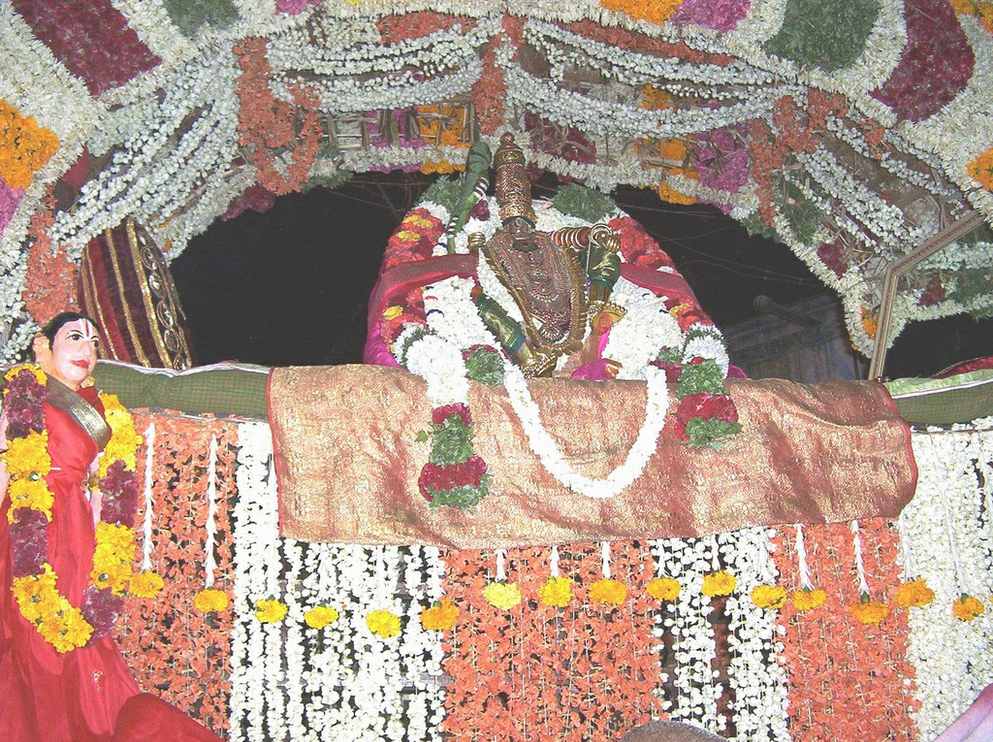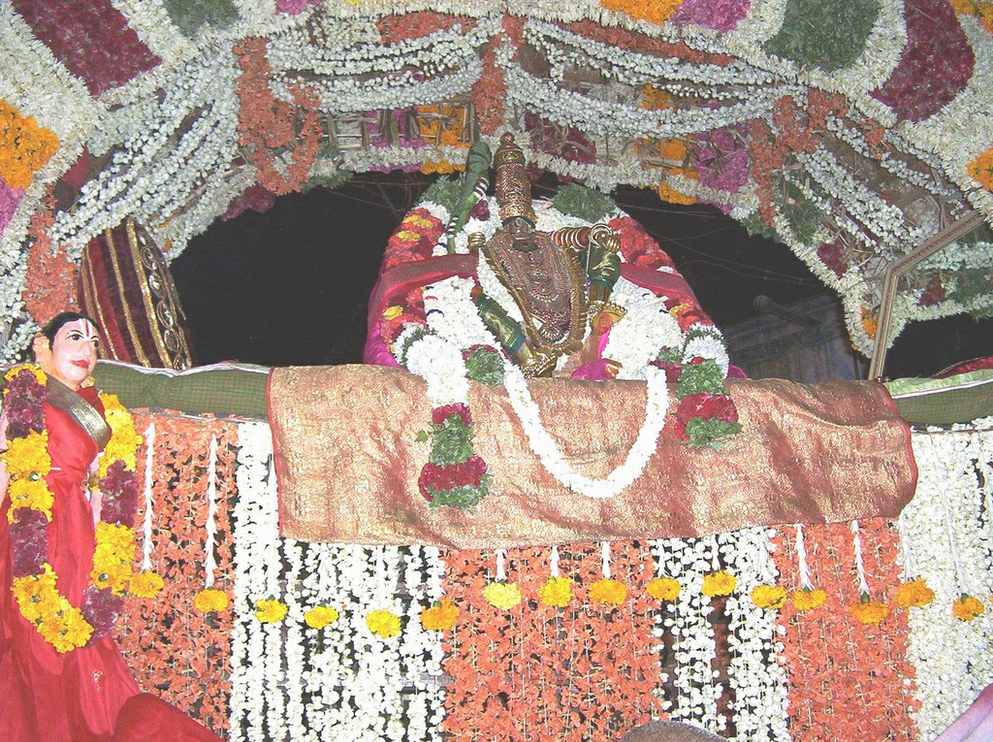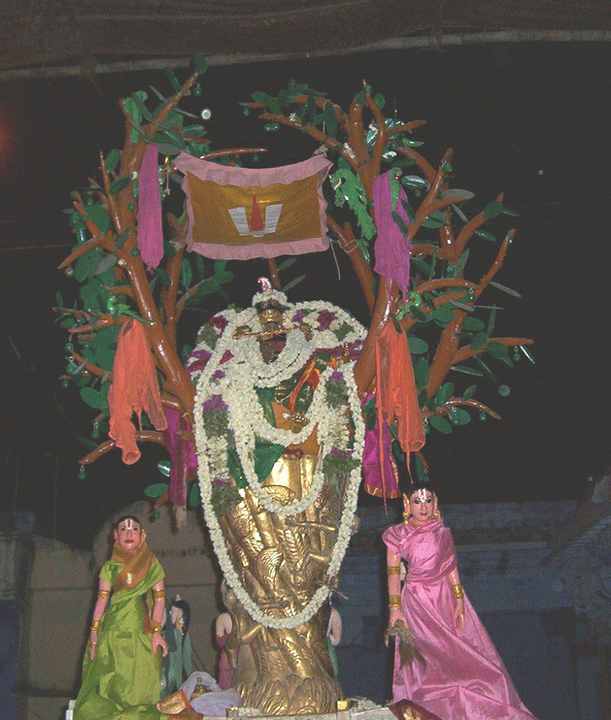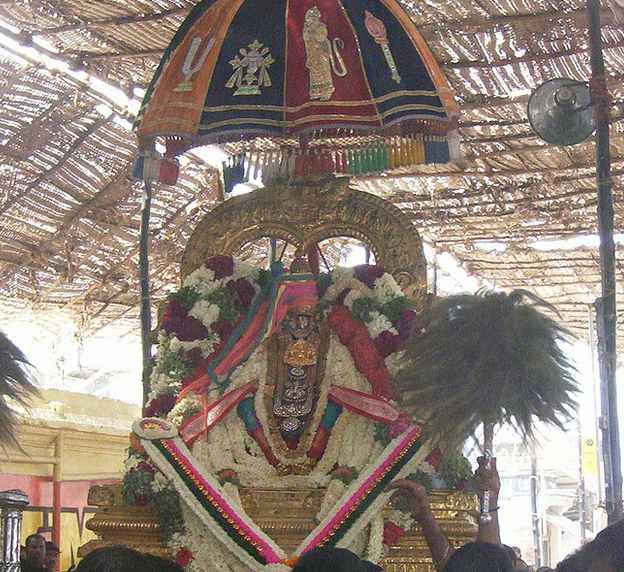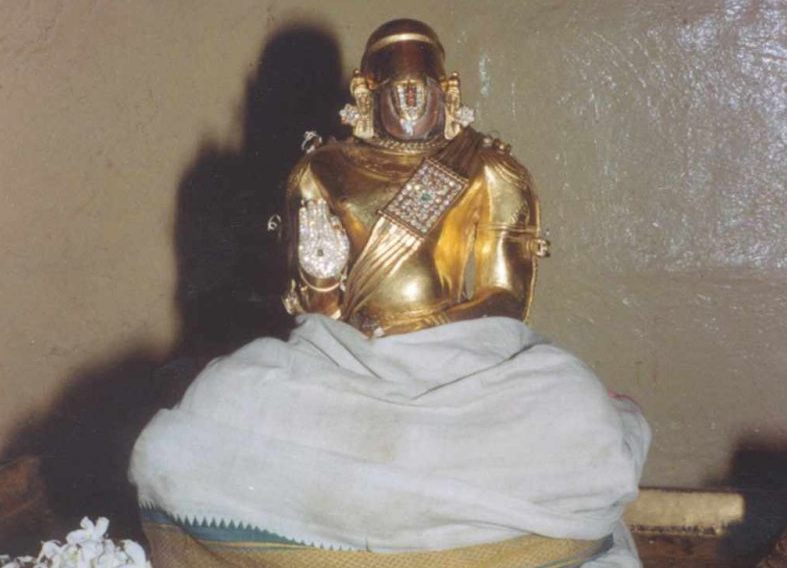Today, 24th of May 2013 is Vaikasi Visakham Thirunakshatram of Swami Namazhwar.
Alwarthirunagari – Vaikasi Thirunaal utsavam
Nammalwar, is an incarnation of Vishvaksena ( the Chief of staff of Lord Vishnu ) Date of birth: Several theories have been expounded regarding the dates of Alwars and Acharyas. for example, Nammalwar is reported to have been born on the 43rd day of commencement of the present Kaliyuga in 3102 BC. He was born in the month of Vaikasi, in Suklapaksha, on Pournami day, a Friday in the constellation of Visaka in Karkataka Lagna.(PAL)
He was the son of Kaari, a Vellala agriculturist of Tirukkurugur on the banks of Tamraparni river and his mother was Udayanangai of Tiruvanparicharam in Kerala. The familial genealogy of Satakopa is as follows: Vibhutinatha – Dharmadhara – Chakrapani – Achyuta – Paataalalochana – Porkaari – Kaari ( who married Naathanayika aka Udaiya nangai – Satakopa. (PRA)
Since the child did not open its eyes to see or mouth to eat, never cried like other children, the parents named it as ‘Maaran“-‘ one different.’ He controlled the wind called ‘Satam ‘ which afflicts the just born. According to Garbhopanishad, the foetus in the womb develops consciousness of its past births, present existence and the future destiny and resolves never again to go through the cycle. But, even as the child is born, this wind enters the newborn and makes it oblivious of all the consciousness and becomes worldly- conscious. He banished it with indignation even as he was born and established himself in yoga. Therefore, he was called ‘ Sata kopa‘.
His parents prayed to Lord Adhinatha and put the child in a cradle and left it under the tamarind tree that stood beside the temple. It is believed that the tree is an incarnation of Aadhi Sesha, the serpent couch of Lord Narayana. The child grew up in the same state of trance for 16 years. People wondered at this marvel of a boy and everyone called him Nam Alwar- Our Alwar. Incidentally, this is the way he was called by the Lord himself. It is said that even Christians, Muslims, Bouddhas, Jains and Saivites marvelled at this phenomenon and claimed him to be one of their own.( Vide Introduction to 4000 Divya Prabandham published by Lifco Associates, Madras )
Just like the word “Rama” denotes, Sitaraman, the word Alwar denotes unerringly Nammalwar. There was and is none like Satakopa since he regarded Kannan as ” Unnum Sorum, Parugu Neerum Thinnum Vetrilayum”. Lord Krishna lamented in Bhagavad Gita ” Vaasudevah Sarvam Ithi Sa Mahaathmaa Su Durlabhah” perhaps having in mind his having to ascend to His Nitya Vibhuti before the birth of Satakopa. Similarly, Satakopa lamented on his not having been born a few days before since he narrowly missed seeing Kannan who by then had ascended to his Parama Padam. His involvement with the wonderful experiences of Krishna Avatar was such that Bhattar in his Rangaraja Stavam observed that it is the thirst of the love of Krishna that had personified itself and came down to earth as Para Ankusa.(PPM)
Swami Desika in Sloka 4 of his Yatiraja Saptadhi pays homage to Nammalwar thus:-
There was at that time a Brahmin saint by name Madhurakavi of Tirukkolur who was visiting holy places in the north. When he was at Ayodhya, he saw a bright light shining in the far south which seemed to beckon him. Following the direction of the light, Madhurakavi reached where Maaran was. When Madhurakavi posed a ‘bit question’ to the boy, he opened his eyes, looked at Madhurakavi and gave a ‘fit answer.’ Immediately, Madhurakavi acknowledged the boy as his Guru and the latter acknowledged Madhurakavi as his disciple.
The manner in which the individual soul is afflicted when entangled with `Prakriti‘ or matter which includes our body is vividly portrayed in the conversational session of Sri MADHURA KAVI with his preceptor NAMMALWAR. MADHURAKAVI asks NAMMALWAR “If the `small one’ is born in the womb of the `dead one’ what will it eat and where will it lie?”. NAMMALWAR answers :” `That’ it will eat, and `There’ it will lie”. The `small one’ refers to the individual soul ( subtle spirit) which is believed to be atomic in size. The `dead one’ refers to the (gross matter) body. Only when the soul enters the body, the body comes to life. Before the soul entering it and after the soul leaving it, the body is only a dead matter or corpse. The soul when it gets into the body and so long as it remains therein it experiences the pleasures and pains through that body and the senses, quite oblivious of its own innate nature of knowledge and bliss and unaware of its creator, the Paramatma. This is the meaning of the reply of NAMMALWAR. In other words, the distinction of the three entities and the behavior of the soul when in conjunction with the body have been dramatically displayed. This brought the master and disciple together. After his encounter with Madhurakavi, Nammalwar stayed under the tamarind tree for 32 years
Lord Adhinatha presented him with a garland of Vakula flowers from his own neck. Hence, the name VAKULABHARANAN. The Lord called him “OUR ALWAR”- NAM ALWAR. As already mentioned all people at that time also called him, thereupon, endearingly as Nam Alwar. The sectarians of all ages and faiths feared him just like an elephant fears the sharp iron goad. Hence, his name ” PARA ANKUSAN“(LA) He is also known as Sataari, and Kurugai Piraan.
He is considered to be the foremost among the Alwars and foremost among the Acharyas as well. His works brim with devotion, love, poetic excellence and literary flavor that hold in its grip the attention of anyone who cares to read. They explain the essence of Vaishnavism, Tattva trayam, Artha panchakam etc and is deservedly called the ‘Tamil Veda‘. In fact, he is known as “Vedam Tamizh Seitha Maaran” The four works of Nammalwar written down by Madhurakavi are considered to be the essence of the four Vedas.
(i) Tiru viruttam in a special style in Tamil called Viruttam in 100 verses is the essence of RigVeda.
(ii) Tiruv asiriyam in 7 verses is the essence of Yajur veda
(iii) Periya Tiruv antadhi in Antadhi style of 87 verses is the essence of Atharva Veda and
(iv) Tiru voi mozhi in 1002 verses is the essence of Sama Veda.
The sentiments expressed in every single verse of his works would kindle an insatiable interest and transport one to an enrapturing state of Bhakti ecstasy. It is very difficult to select one verse in preference to another for appreciating the poetic excellence or the emotional content of his works. It is more because of our own limitations, space and time restrictions that we have to restrict ourselves to just a few of his expressions. But, even one among the many of his incomparable verses can bestow on the reader an unprecedented delectable experience.


